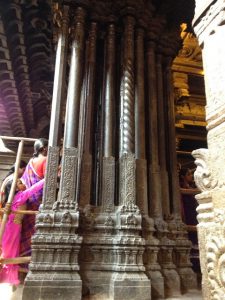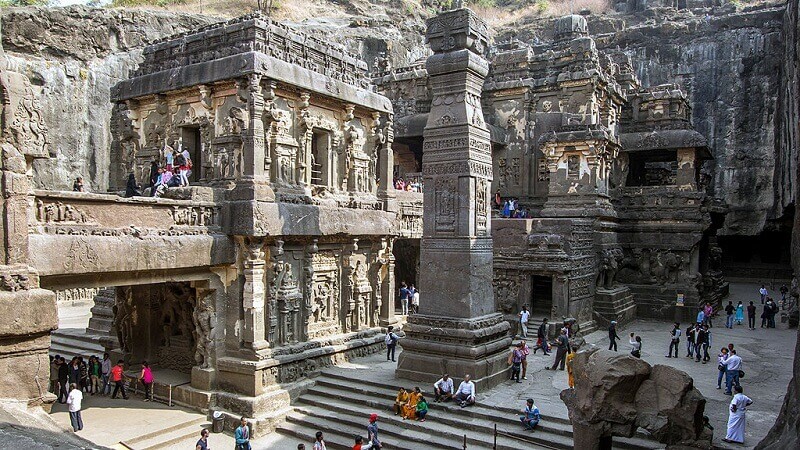Hindu temples are one of the most treasured assets depicting faith, art, culture, and architect in India. Many temples are 1000 years old, and their architecture is still awe-inspiring.
The true beauty, the intricate work and the marvelous architectural competence that has gone into building these temples is either not known to many or is hugely underrated. In this write up, we are covering 4 ancient Indian temples (of many many more) that would prove how advanced Indian science, art, and mathematical knowledge was.
- Vidyashankara Temple, Sringeri, Karnataka:

This temple was built in the 14th century and is dedicated to Lord Shiva. The temple stands almost at the entrance to the River Tunga and is an architectural marvel.
This temple has 12 pillars around the mandapa with 12 solar signs, popularly known as Rashistambhas (zodiacal pillars). Every morning when the first rays of sun fall on the temple, they hit the pillar denoting the month of the year. Windows and doors along the temple walls are arranged such that equinoxes sunrise views reach the deity.
Some other delicate carvings that also denote mathematical precision are the lions that are engraved in biped positions on the pillars. There are stone balls inside the growling faces of the lions, and they can be rotated inside their mouths.
- Nellaiappar Temple, Tirunelveli, Tamil Nadu :

This temple is another supreme example of marvel of engineering & technology.
There is a cluster of 48 pillars surrounded by a central pillar that were carved from a single rock. Remarkably, surrounding pillars vibrate when one of them is tapped. The pillars can produce the 7 basic musical notes – Sa Re Ga Ma Pa Dha Ni. Sadhguru comments, “Not only did Tamil culture produce exemplary musicians, it even made stones sing a symphony!”
In fact, according to some texts, the mystery of these musical pillars in Nellaiappar Temple has remained unsolved for the last 1300+ years, which probably means the architects have not been able to decipher the design and operational mechanism of these pillars.
- Mahadeva Temple Khajuraho, Madhya Pradesh:
Khajuraho temples are exemplary illustrations of creativity, devotion and artistry.
Most Khajuraho temples were built between 950 to 1050 by Great Chandela Dynasty.

The entire main building of Mahadeva temple is made with sandstone, with the base constructed with a granite foundation. The surprising element is that there were no mortars used in the construction. The stones were cleverly connected with the mortis and tenon, held together with gravity.
Another irrefutable symbol of incredible styles of architecture in the Mahadev Temple are the sculptures that are carved on huge stones that portray the matters of everyday life. The quality of the stones used in making the sculptures was exceptional, hence the accurate and realistic carvings as depicted in manicured nails and detailed jewelry.
- Kailasa Temple, Ellora, Aurangabad, Maharashtra:
This temple is in a matchless wonder of vertical excavation. This is the only temple where the architects started at the top of the rock and excavated downwards. stone blocks.

To elaborate the engineering marvel, let us understand that it was made by cutting a single rock from top to bottom, every single design and measurement was planned absolutely accurately as once the rock was cut, there was no chance to modify it by adding any extra piece of rock. This whole temple is made of only one rock; not even a small piece of rock was joined separately for any design or support.
According to historians and archeologists it is estimated that approximately 400,000 tons of rock was removed from the site in making of this temple. This sheer amount of heavy rock was never found or seen by anyone in and around the site. Where the debris was consumed or dumped is still an unanswered question!
This temple was chiseled amazingly on the rock surface. Even the present-day architects are awe-struck with this creation i.e. how this engineering expertise was achieved with primitive tools and technology.
The ancient Hindu knowledge of science and engineering was superior than many give it credit for. The largest manifestations of engineering marvels are seen in well planned ancient cities, drainage systems, water harvesting systems, and of course the temples that were the centers of art, culture, and economy.
Lexicon World will continue to bring such architectural marvels to the knowledge of its readers.
Monica (Managing Editor) is the quintessential researcher - she thrives on showcasing overlooked aspects that form the foundation blocks of people, places and issues. She is a social scientist by profession with masters in Economics and loves to travel.